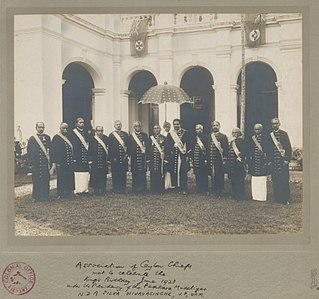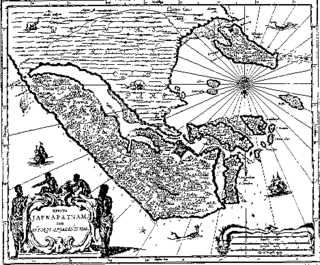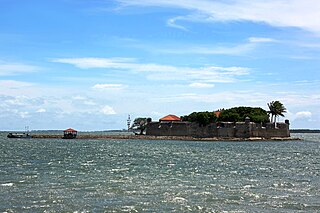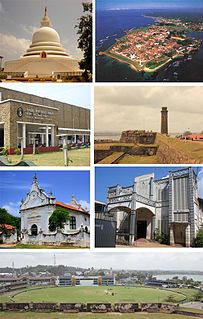
The Diocese of Jaffna is a Roman Catholic diocese for northern Sri Lanka, that dates back as far as the time of St. Francis Xavier. The current bishop is Justin Gnanapragasam.

Mudali was a colonial title and office in Ceylon. The Portuguese colonials created the Mudaliyar class in the 17th century by enlisting natives of different castes from the coastal areas.

Dutch Ceylon was a governorate established in present-day Sri Lanka by the Dutch East India Company. Although the Dutch managed to capture most of the coastal areas in Sri Lanka they were never able to control the Kandyan Kingdom located in the interior of the island. Dutch Ceylon existed from 1640 until 1796.
Yalpana Vaipava Malai is a book written by a Tamil poet named Mayil Vaakaanar in Tamil மயில் வாகனார் 1736. This book contains historical facts of the early Tamil city of Jaffna. The book which may have been written around 1736 during the Governorship of Jan Maccara, the then Dutch Governor of Jaffna. It was translated from Tamil by C. Brito, and was first published in 1879. The work is looked upon as one of great authority among the Tamils of Jaffna.

The American Ceylon Mission (ACM) to Jaffna, Sri Lanka started with the arrival in 1813 of missionaries sponsored by the American Board of Commissioners for Foreign Missions (ABCFM). The British colonial office in India and Ceylon restricted the Americans to the relatively small Jaffna Peninsula for geopolitical reasons for almost 40 years. The critical period of the impact of the missionaries was from the 1820s to early 20th century. During this time, they engaged in original translations from English to Tamil, printing, and publishing, establishing primary, secondary and tertiary educational institutions and providing health care for residents of the Jaffna Peninsula. These activities resulted in many social changes amongst Sri Lankan Tamils that survive even today. They also led to the attainment of a lopsided literacy level among residents in the relatively small peninsula that is cited by scholars as one of the primary factors contributing to the recently ended civil war. Many notable educational and health institutions within the Jaffna Peninsula owe their origins to the missionary activists from America. Missionaries also courted controversy by publishing negative information about local religious practices and rituals.

The Vanni Nadu were feudal land divisions ruled by chiefs south of the Jaffna peninsula in northern Sri Lanka. These chieftaincies arose in the 12th century, with the rise of the medieval Tamil kingdom's golden age and the collapse of the Rajarata kingdom. The chieftaincies developed in sparsely settled areas, and were ruled by Vanniars. An extension of the Jaffna kingdom's territory, the chiefs of the Vanni Nadu were, for most of their existence, tribute-paying subordinates to Jaffna. At 1621, the Jaffna Kingdom was conquered by the Portuguese and the Vanni chiefs became tributaries of the Portuguese Ceylon. The Portuguese colony in Sri Lanka was later taken over by the Dutch. During the Dutch rule it came to Vannian resistances against the colonial rule, one of these was the rebellion of Pandara Vanniyan. Allied with the Kingdom of Kandy, Pandara Vanniyan fought with guerrilla tactics against the Dutch and British. At 1803, he was defeated by Lt. von Driberg and Vanni fell into hands of the British. Vanni had been reincorporated with Jaffna Peninsula to form the Malabar Coylot Vanni country which later became the Northern Province of Sri Lanka.
Migapulle Arachchi also known as Chinna Migapillai, was a feudal lord from the Jaffna Kingdom who became a rebel leader just after its annexation by the Portuguese Empire in 1619. His title Arachchi, is a title given to the commanders of Lascarins or native military forces.

The Portuguese conquest of the Jaffna kingdom occurred after Portuguese traders arrived at the rival Kotte Kingdom in the southwest of modern Sri Lanka in 1505. Many kings of Jaffna, such as Cankili I, initially confronted the Portuguese in their attempts at converting the locals to Roman Catholicism, but eventually made peace with them.

Tellippalai or Thellippalai is a small town in the northern Jaffna District of Sri Lanka. It is located about 15 kilometers north of Jaffna town along the Kankesanthurai road

Portuguese Ceylon was the control of the Kingdom of Kotte by the Portuguese Empire, in present-day Sri Lanka, after the country's Crisis of the Sixteenth Century and into the Kandyan period.

Jaffna Fort is a fort built by the Portuguese at Jaffna, Sri Lanka in 1618 under Phillippe de Oliveira following the Portuguese invasion of Jaffna. The fort is located near Karaiyur. Due to numerous miracles attributed to the statue of Virgin Mary in the church inside the fort, Jaffna Fort was named as Fortress of Our Lady of Miracles of Jafanapatão. It was captured by the Dutch under Rijcklof van Goens in 1658 who expanded it. In 1795, it was taken over by the British, and remained under the control of a British garrison till 1948. As the only large military fort in the country, due to the presence of only government and military buildings within its ramparts, it was garrisoned by a detachment of the Ceylon Army.

Fort Hammenhiel is a fort built around a small island between the islands of Kayts and Karaitivu of Jaffna Peninsula in Northern Sri Lanka.
The Colombo Journal was a short-lived English-language bi-weekly newspaper in Ceylon. The newspaper started on 1 January 1832 with George Lee as editor. George Lee was the Superintendent of the Government Press and later Postmaster General. The newspaper had the support of the government and Governor Robert Wilmot-Horton. Apart from Horton and Lee other senior government officials who wrote for the newspaper included the governor's private secretary Henry Tufnell and George Turnour. Criticism of the British government led to the newspaper being closed by the Colonial Office on 31 December 1833.
The Ceylon Herald was an English-language newspaper in Ceylon. After The Ceylon Chronicle closed down on 3 September 1837 Mackenzie Ross bought the printing press and started The Ceylon Herald on 7 September 1838. The newspaper opposed the government bitterly. Governor Stewart-Mackenzie sued Mackenzie Ross for libel after The Ceylon Herald published an article alleging that the governor had gone to the Veddah country to purchase large amounts of land at nominal prices. Mackenzie Ross was acquitted after a trial before Chief Justice Anthony Oliphant.
Gualterus "Wouter" Woutersz was commander of Jaffna for the Dutch East India Company and interim Governor of Dutch Ceylon between the departure of Stephanus Versluys on 25 August 1732 and the arrival of Jacob Christiaan Pielat on 2 December 1732.
Jacob de Jong was an acting Governor of Zeylan during the Dutch period in Ceylon. He was appointed on 26 February 1752 and was Governor until 10 September 1752. He was succeeded by Joan Gideon Loten.
Lubbert Jan baron van Eck was the 31st Governor of Ceylon during the Dutch period in Ceylon.
Sir John Charles Samuel Grenier was a Barrister and the 17th Attorney General of Ceylon. He was appointed on 30 September 1886, succeeding Francis Flemming, and held the office until his death in 1892. He was succeeded by Charles Layard.












